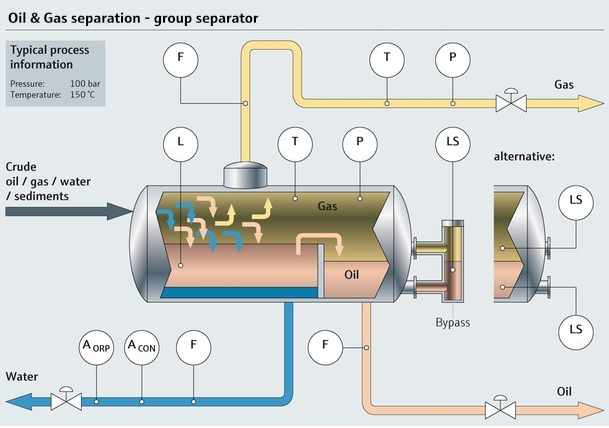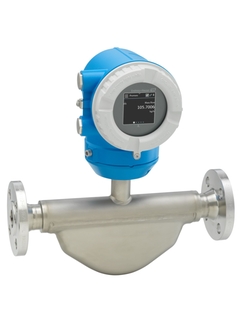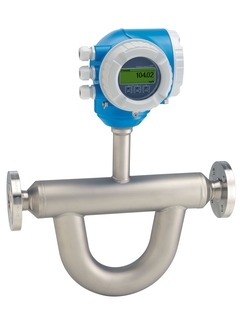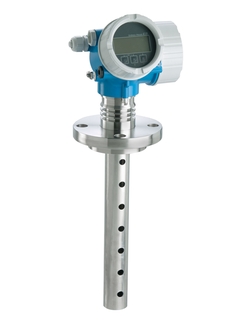Coriolis flowmeter for precise and accurate flow measurement
Technology you can trust in hazardous areas, critical applications and highly regulated industries The process control industries are characterized by […]
Separating hydrocarbon liquids and gases from water and sediments poses challenges because numerous parameters must be monitored. Measurement of these parameters—including temperature, pressure, flow, and level—must be accurate and reliable to ensure effective operation.
In its simplest form, oil and gas (O&G) separation takes place in multiple stages, with the initial stage usually called a test or bulk separator. As crude is pumped into the separator, oil overflows the weir and gases vaporize, leaving water and sediment behind.

Crude slates can vary greatly, measurement becomes complex as the variations increase, reliance upon advanced technologies and expert know-how is critical. Endress+Hauser provides both elements to users around the world, helping drive optimal separation performance by:
While measurement is similar for all types of O&G separation processes, there are nuances to the process depending on crude oil density. With a portfolio of reliable measurement technologies covering process variables at every stage, Endress+Hauser instrumentation can optimize separation and enable effective handling of oil, water, gas, and sand—regardless of your crude slate.


Separators use dump valves to release the water from the separator prior to it flowing over the weir. When looking to monitor or improve control of your dump valve, having an accurate and reliable interface measurement is critical prior to opening, and having flowmeters with diagnostic capabilities to tell you if you have oil in your water leg or water in your oil leg can prove beneficial during allocation.
Level and flow measurements are hypercritical in this process and newer technology such as Coriolis for oil and electromagnetic for water provide more than just flow measurements, they also provide diagnostics that can determine the quality of your separation process.
Most of today’s horizontal light oil (API 45-31.1, < 870 kg/m³) separators are equipped with mechanical level and density control devices. Mechanical devices pose regular maintenance concerns, and they necessitate specific adaptations depending on the density of oil being measured.


Leveraging guided radar level measurement technology, Endress+Hauser’s Levelflex FMP55 overcomes the limitations of mechanical devices to optimize the separation process for light crude oil, resulting in:
Medium crude oil (API 31.1-22.3, 870-920 kg/m³) separation poses the challenge of measuring both overall crude oil and interface levels, impossible with a single device using older technologies. Additionally, an emulsion layer is often present, and if this layer exceeds about two inches in depth, a standard guided-wave radar device cannot accurately measure the level beneath it.

Endress+Hauser’s multi-parameter guided wave radar technology simplifies the medium crude oil separation process by providing O&G processors with the ability to monitor oil and interface levels through any emulsion layer, using a single device. With fewer devices to maintain, this results in reduced operating costs and minimal process downtime.
The high densities of heavy (API 23-10, 920-1000 kg/m³) and extra-heavy crude oil (API < 10, > 1000 kg/m³) pose limitations to traditional measurement technologies during separation. In addition to incomplete process data, the need to install sensors within a separator renders them vulnerable to contamination.

Endress+Hauser’s Gamma Density Profiling System enables installation outside the separation vessel, empowering O&G processors to:
With over 300 radiometric interface measurement and density profiling systems installed and in operation worldwide, Endress+Hauser’s technology saves an estimated 8,500 liters of demulsifier and anti-foam agents every year, while reducing the risk of foaming inside separators by 5%. This helps ensure maximum resource extraction while minimizing operating costs.
In addition to providing cutting-edge measurement technology, Endress+Hauser’s service teams are ready to assist O&G processors with inspection, commissioning, engineering, calibration, and training services to maintain efficient, safe, and clean separation.
Technology you can trust in hazardous areas, critical applications and highly regulated industries The process control industries are characterized by […]
Mason Flannery is a product marketing manager here at Endress+Hauser, specializing in flow measurement technologies. To help answer some frequently […]
In the previous blog in this series, we described the importance of interface level measurement in the oil and gas […]
Comments